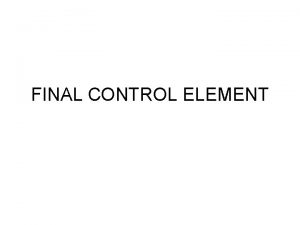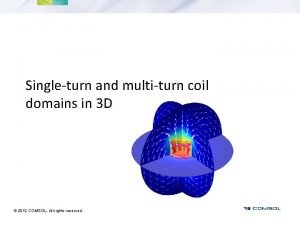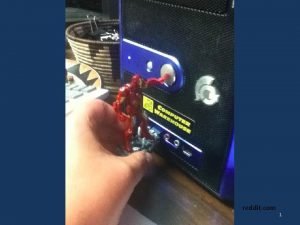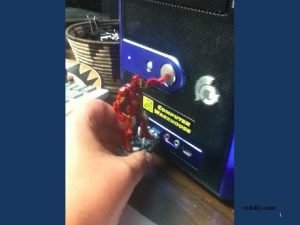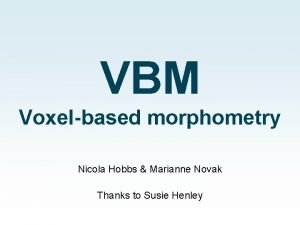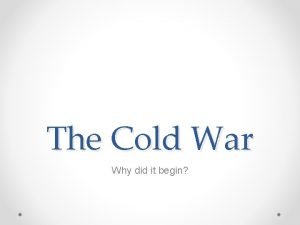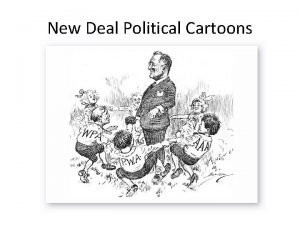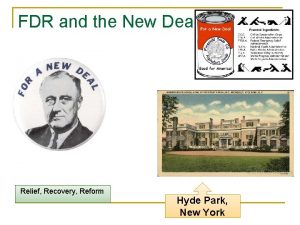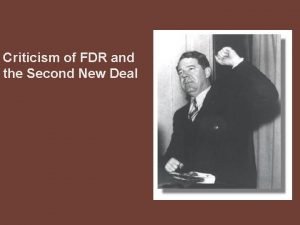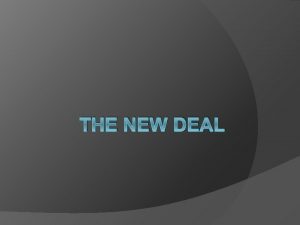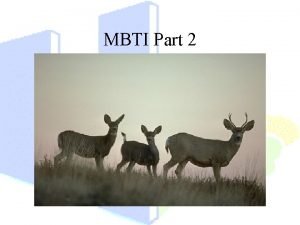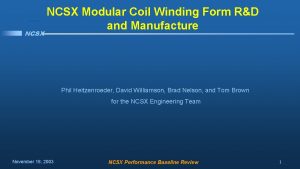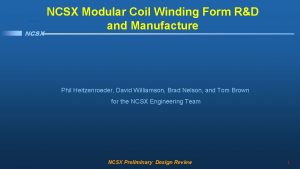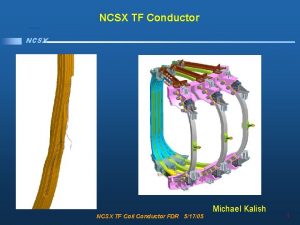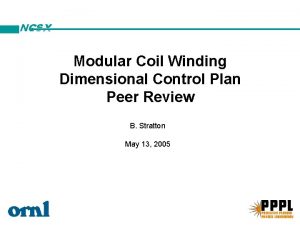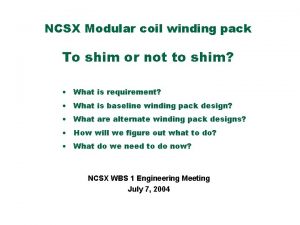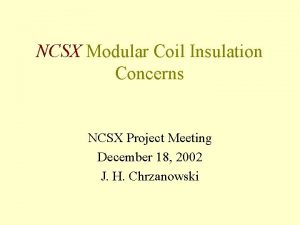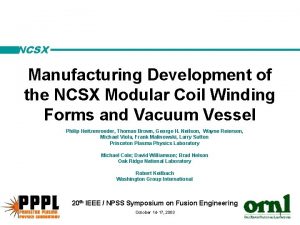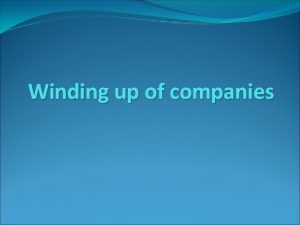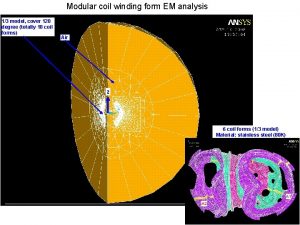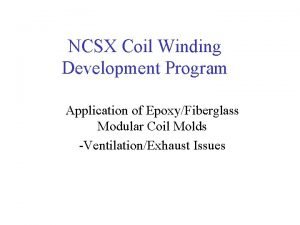NCSX Prototype Modular Coil Winding form FDR Phil











- Slides: 11

NCSX Prototype Modular Coil Winding form FDR Phil Heitzenroeder PPPL September 30, 2003 NCSX Modular Coil Winding Form Prototype FDR 1

The Prototype Winding Forms ¡ ¡ ¡ Each of the two winding form teams will produce one full-scale, fully machined “Type C” winding form. The prototypes are expected to be virtually identical to the production forms. Our intention is to only use the winding forms for development purposes. It is unlikely, but if no significant changes are made to the production winding form designs and specifications and if the prototypes meet requirements, we may consider using them in NCSX. September 30, 2003 NCSX Modular Coil Winding Form Prototype FDR 2

Goals of the Manufacturing Study / Prototype Fabrication ¡ The winding form is a critical key component of NSTX. The most important goals of this effort is to gain experience fabricating such a highly shaped, closely toleranced casting. l Important areas: casting quality and properties; dimensional control; permeability control; machining; cost and schedule control. ¡ This fabricating experience will also reduce uncertainties and provide the basis for the subcontractors to develop firm cost and schedule proposals for the (18) production winding forms. ¡ To provide a firm foundation for the “production” parts to be fabricated which meet their technical specifications on schedule and on cost. l Process optimization with an eye towards the “production” phase (examples: reduced overcast allowance; changes in machining processes; changes in NDT). ¡ To provide prototype winding forms that will be used to develop the winding manufacturing methods. ¡ It’s a long shot, but if everything goes well with the prototype manufacture, they may be the first two winding forms for use in NCSX. September 30, 2003 NCSX Modular Coil Winding Form Prototype FDR 3

Major Elements of the Prototyping Effort Done! ü ü ü ü Describe manufacturing methods. Choose the alloy for the casting. Manufacturing evaluation of candidate features. Describe mold fabrication. Perform flow/solidification analysis. Describe the casting process details. Describe post-casting processing: ü ü ü ü Now To be completed by May ‘ 04 ü Ø v v v Non-destructive testing; Dimensional inspection & verification; Winding form repairs; Heat treatment; Machining and final finishing; Final inspection Recommend changes to design or specification. Preliminary Manufacturing / Inspection / Test (MIT) and Quality Assurance Plans for production coils. Prepare budgetary cost and schedule estimates. Develop MIT / Quality Assurance plans for the prototype. Actual manufacture of a Type C winding form prototype. Develop Final MIT / QA Plans for the Production Winding Forms. DEVELOP A FIRM FIXED PRICE AND SCHEDULE PROPOSAL. September 30, 2003 NCSX Modular Coil Winding Form Prototype FDR 4

Documents, Reference Drawings and Pro-E Models ¡Statement l of Work NCSX-SOW-141 -01 -XX ¡Specification l ¡ NCSX Product Specification NCSX-CSPEC-141 -01 -00 for the Prototype Modular Coil Winding Form (September 30, 2003) Drawings ¡ ¡ Models l l SE-141 -113; Sheets 1 -5. Just released! The list of applicable models is defined in the Specification. Recognizing that procurement of castings is different than procuring a “finished” part inasmuch as the casting manufacturer needs to produce a model with certain features and characteristics required for their casting process: Each Subcontractor will modify the models as required for their casting process: ¡ l l l Add any required fillets, draft angles, “padding” where the wall thickness may be too thin for casting, and smooth surfaces as required to ensure “demolding”. Subcontractors will return STEP files or Pro-E files of their modifications to PPPL/ORNL will verify that the essential dimensions and features are acceptable and, if acceptable, will formally approve them “FOR FABRICATION. ” September 30, 2003 NCSX Modular Coil Winding Form Prototype FDR 5

This is Sheet 1 of the pdf reference drawings. This defines the tolerances required. September 30, 2003 NCSX Modular Coil Winding Form Prototype FDR 6

Essential Characteristics of the Casting Alloy 0. 2% Yield strength: >180 MPa (>26 ksi) at room temperature (RT); >360 MPa ( >52 ksi) at 77 K. ¡ Ultimate tensile strength: >360 MPa (52 ) at RT; >690 MPa (99. 7 ksi) at 77 K. ¡ Elongation: 30% (min. ) at RT and 77 0 K. ¡ Thermal conductivity: >9. 7 W/m-K at RT; >7 W/m-K at 77 K ¡ Electrical Resistivity: >83 x 10 -8 W-m at RT; >64 x 10 -8 W-m at 77 K ¡ The local relative magnetic permeability shall not exceed 1. 02 Both Teams Have Developed Proprietary Alloys Which Meet These Characteristics. ¡ September 30, 2003 NCSX Modular Coil Winding Form Prototype FDR 7

Manufacturing / Inspection / Test / Quality Assurance Plans Will Guide the Production of the Prototypes and Production Articles A multi-step process is used to develop them: 1. A Preliminary MIT/QA plan was developed for the “production” winding forms. (May, 03) ¡ ¡ 2. A Preliminary MIT/QA plan was developed for the “prototype” winding form. (September, 03) ¡ ¡ 3. This provided the basis for their budgetary price and schedule estimates which fed into our CDR plans. We reviewed these plans with them via teleconference and these comments were fed into (2) below. This is essentially the same as that developed in (1) but limited specifically to the prototype. We reviewed these plans with them via teleconference Both teams are now finalizing the MIT/QA plans for the prototypes. ¡ ¡ September 30, 2003 Mostly what remains to be done is a little “fine tuning” and to develop supporting procedures. They’re developing schedules to make sure the various parts of the MIT/QA plans are finalized before their need date. NCSX Modular Coil Winding Form Prototype FDR 8

Special Situations ¡ ¡ ¡ Poloidal breaks: electrical resistance shall be >500 k. W when tested at 100 vdc. Machined surfaces: < 125 micro-inches RMS. Defects and Repairs: l l l September 30, 2003 Uniform “scallops” which may result from machining processes may be acceptable, subject to PPPL’s approval. Surface depressions with areas less than 4 sq. in. and no cracks may, with PPPL’s approval, be repaired by filling with a suitable filled epoxy. Major defects (ie, when the cavity exceeds 10% of the wall thickness or 1”, whichever is less or when the extent of the defect exceeds 10 sq. in. ) shall be repaired by welding. NCSX Modular Coil Winding Form Prototype FDR 9

Next steps ¡ ¡ ¡ Assuming a successful FDR, we will address any chits which may be submitted during this FDR (target date: 2 October. ) “Promote” the reference drawings and Pro-E models to For Fabrication. (target date: 2 October. ) Release Rev. 1 of NCSX-SOW-141 -XX target date: 2 October. Release Rev. 0 of NCSX-CSPEC-141 -00 (Product Spec. for the Prototype Winding Form) target date: 2 October. (note: this will be Rev. 0 because only a preliminary, unsigned draft has been used thus far). The final step will be for L. Sutton to formally issue change orders to both subcontractors authorizing them to proceed with fabrication of the prototype, subject to finalization of their MIT/QA plans for them. Target date: Friday, 3 October. September 30, 2003 NCSX Modular Coil Winding Form Prototype FDR 10

Conclusion ¡ ¡ This is not a typical FDR inasmuch as castings require the subcontractors to “refine” the customer’s drawings to produce castings from which the customer’s finished part can be attained. The Subcontractor teams have really become an integrated part of the NCSX Team. l l ¡ The MIT/QA plans are not yet finalized, but we don’t believe this is an issue. l l ¡ They participated in geometry refinement and understand the “fine points” of developing these models extremely well. A good relationship for success has been developed. This is taking time primarily because we insist on highly detailed, well backed up plans. This will assure that there be a detailed history of the prototype manufacturing details and will develop a the good quality culture these parts require. Back-up procedures need to be written yet , but otherwise the MIT/QA plans are almost done. Keeping the MIT/QA finalization ahead of needs should not be a problem. We expect these MIT/QA plans to serve the needs of production phase with only modest changes. This is a good investment. l We expect some simplifications and refinements as a result of the prototype experience. September 30, 2003 NCSX Modular Coil Winding Form Prototype FDR 11

